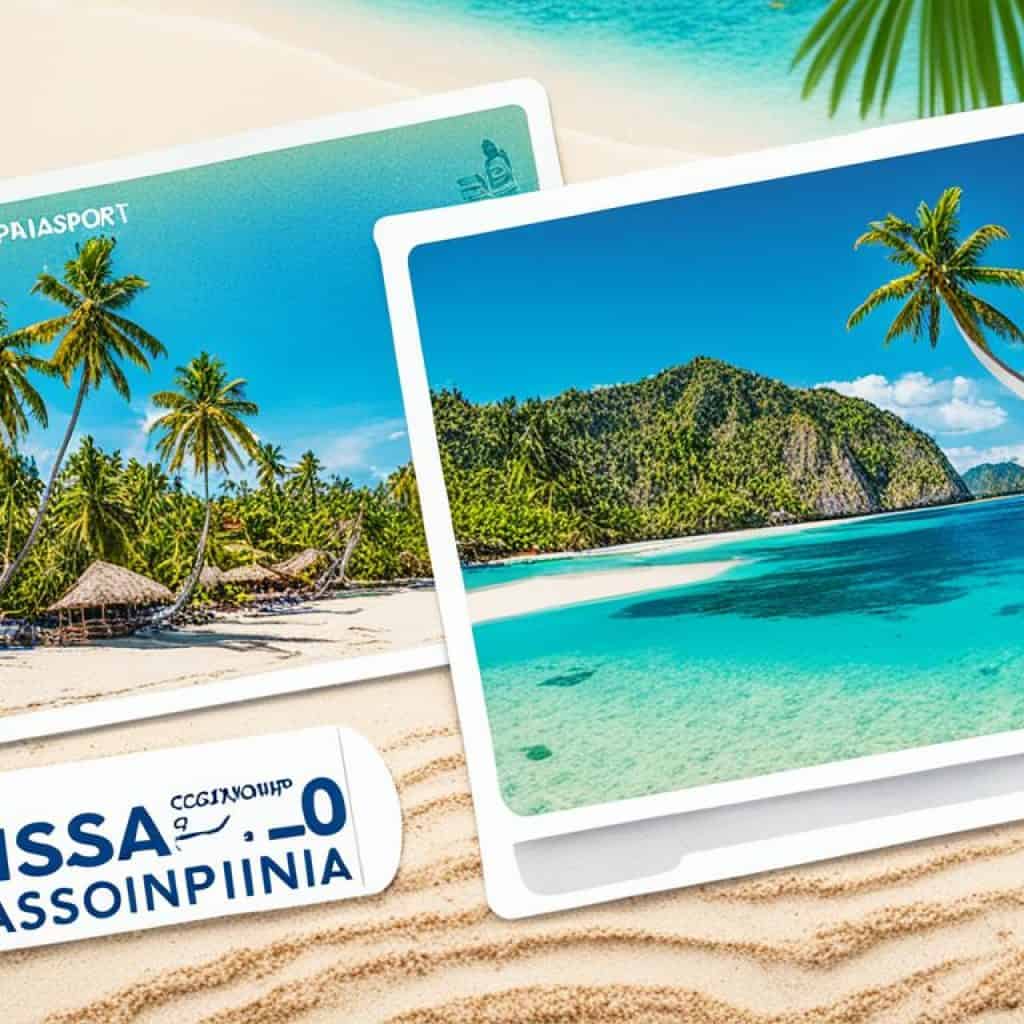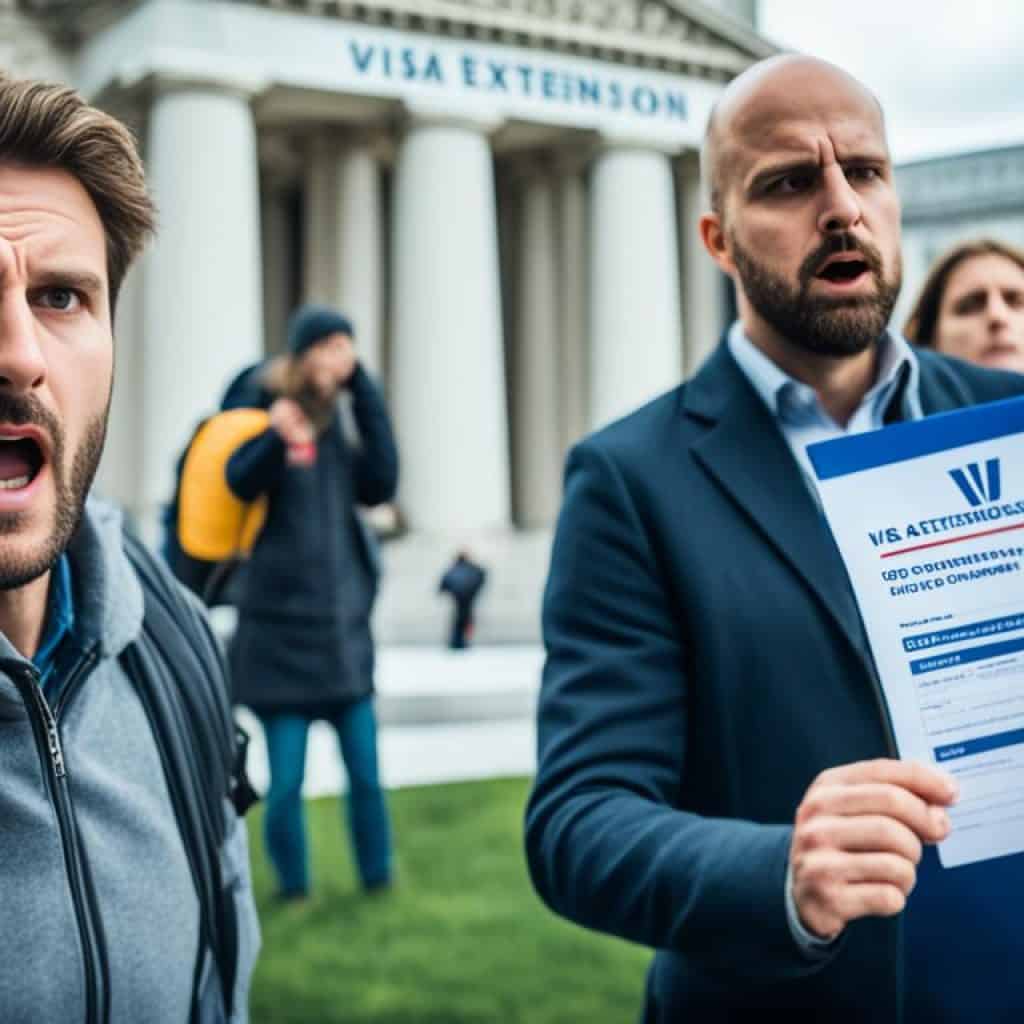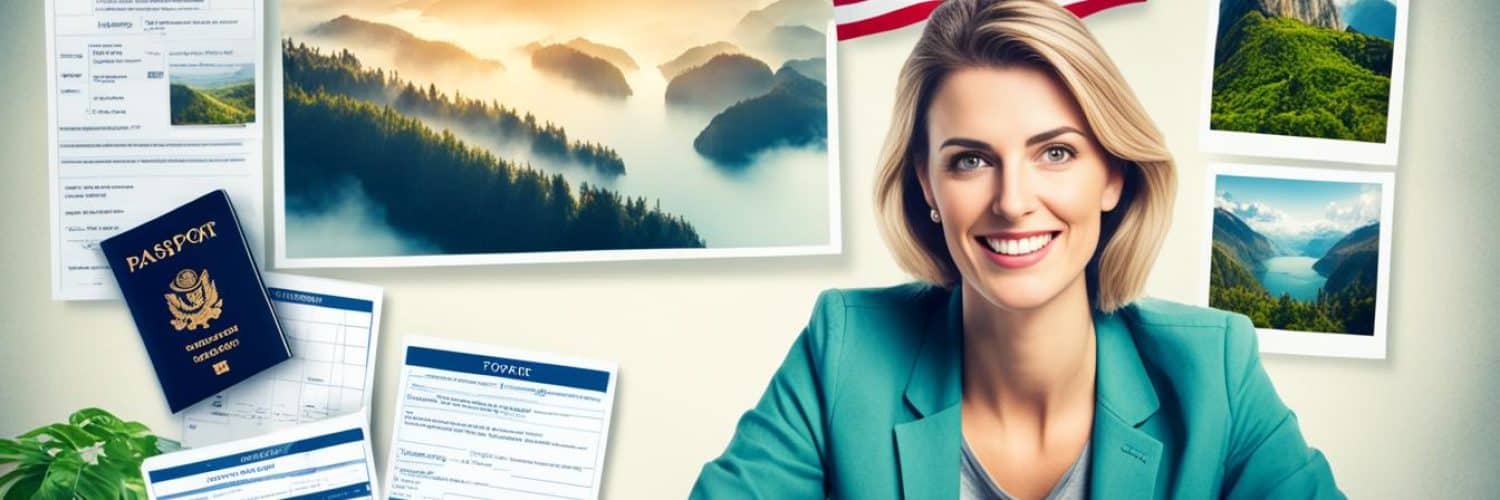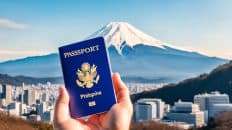Planning a trip to the Philippines and want to stay longer? This guide will help you extend your tourist visa easily. It gives you all the info and requirements needed. So, if you love beautiful beaches or the culture, we’re here for you.
Key Takeaways:
- Visitors to the Philippines who want to stay longer than the standard tourist visa allows will need to apply for a visa extension.
- There are different types of visas issued by the Philippine government, including tourist visas, business visas, and student visas.
- You can apply for a Philippines visa extension at an embassy or consulate, on arrival at an international airport, or online through the Manila Economic and Cultural Office website.
- The processing time for a Philippines visa application can vary, so it’s important to apply well in advance of your intended travel date.
- The requirements for a Philippines visa extension include a completed visa application form, a valid passport, proof of accommodation and financial means, and payment of the visa fee.
Do I Need a Visa for the Philippines?
People from many countries can visit the Philippines without a visa for up to 59 days. This list includes countries from ASEAN, the EU, Canada, Australia, and the US. But, if you wish to stay longer than 59 days, you’ll need to get a visa or a visa extension. The Philippines offers easy visa-free access for short trips to citizens of many nations.
Different visas serve different purposes in the Philippines. You can get a non-immigrant visa for short visits. Immigrant visas are for certain categories of people. There are also special visas for investors, those creating jobs, and retirees wanting to live in the Philippines longer.
For citizens of visa-free countries, coming to the Philippines is easy. It’s perfect for those looking for beaches and adventures. But, for longer visits, it’s important to get a visa or extension. This keeps your stay smooth and within the law.
If you’re visiting for tourism, business, or study, knowing the visa rules is key. This article helps you understand how to get a visa extension. It makes your time in the Philippines enjoyable and stress-free.
How Can I Apply for a Philippines Visa?
If you want to visit the Philippines and need a visa, many options are available. You can apply at an embassy or consulate, get a visa on arrival, or apply online. Each method is designed to be straightforward and convenient. Here is a look at the different ways to apply for a Philippines visa:
Embassy or Consulate Application
For those who prefer the traditional way, applying at a Philippine embassy or consulate is the option. First, contact the relevant office to learn about the requirements and documents. After collecting the necessary documents, you must submit them in person. This method lets you ask questions and get immediate feedback on your application.
Visa on Arrival
The Philippines offers a visa on arrival for citizens of most countries at international airports. This option simplifies the process. However, not all nationalities can get a visa on arrival, so check if you’re eligible before traveling. When you arrive, fill out the needed paperwork and pay the fee to get your visa.
Online Application
If you want to avoid waiting in lines, consider applying for a Philippine visa online. The Manila Economic and Cultural Office website has a system for online applications. It’s a convenient, time-saving choice. Remember, online visa applications may not be open to all countries. Visit the MECO website to see if you can apply online and for more details.
How Long Does it Take to Process a Philippines Visa Application?
The time it takes to get a Philippines visa can vary. It depends on where you apply. It can be as quick as two working days or as long as ten. The speed depends on how complete your documents are and how many people are applying.
Apply for your visa well ahead of when you plan to travel. This gives you plenty of time for processing. You’ll also have time to fix any issues that come up.
Visa processing times at Philippines embassies can differ. Some places might finish in two days, others in ten. The time needed can change based on your paperwork and how many applications there are.
To make sure your visa application goes smoothly, apply early. This gives the embassy time to go over your application and decide. Applying early also means you’ll have time to handle any delays or problems.
Remember, the time to process your visa isn’t guaranteed. It can change for many reasons. To avoid problems, apply as soon as you can.
For the best estimate of how long it will take, contact the embassy or consulate directly. Or check their website. They’ll give you the latest info on visa processing times.
Factors that can affect the processing time of a Philippines visa application
- The specific embassy or consulate where you apply
- The completeness and accuracy of your documents
- The volume of visa applications received
- The current workload and staffing levels at the embassy or consulate
Important tips for a smooth visa application process
- Apply well in advance of your intended travel date
- Ensure all documents are complete and accurate
- Follow the instructions provided by the embassy or consulate
- Provide any additional documents or information requested
- Be prepared for potential delays and allow for ample processing time
By following these tips and planning for enough processing time, you can make your visa application easier. It also helps reduce stress and prevents problems.
| Embassy/Consulate | Estimated Processing Time |
|---|---|
| Manila Embassy | 5-10 working days |
| Cebu Consulate | 3-7 working days |
| Davao Consulate | 4-9 working days |
What are the Philippines Visa Requirements?
If you want to visit the Philippines, you’ll need to follow some important steps. You have to show documents and qualifications to enter. Here’s what you typically need for a Philippines visa application:
- A completed visa application form
- A valid passport with at least six months validity
- Passport-sized photos
- A reserved return-flight ticket or a ticket for onward travel
- Proof of sufficient financial means to cover your stay
- Proof of employment based on your status
- Payment of the visa fee
Whether you’re visiting for tourism, business, or studies, these requirements mostly apply. But, remember, some visas might have extra needs. You should check and make sure your documents are right at the Philippine Embassy in your country.
Meeting all these requirements helps your visa application go smoothly. It shows you’re ready to follow the Philippine government’s rules. By getting all your paperwork and finances sorted, you make a strong case for yourself.

Understanding what you need for the visa beforehand makes things easier. Always check the latest rules for your visa type. Talk to the Philippine Embassy or look up the Philippine Bureau of Immigration’s website for up-to-date info.
What are the Philippines Visa Requirements for Minors?
If a minor is traveling alone to the Philippines, they need the following:
- The birth certificate of the minor
- The parent or legal guardian’s valid passport
- A flight itinerary for the minor
- Authorization for the minor to travel issued by the parent(s) or legal guardian(s) and notarized
- Bank statements of the parent(s) or legal guardian(s) issued within the last month
How-To Get A Philippines Visa Extension [2023]: Guide, Fees, Requirements
Getting your visa extended in the Philippines is easy. It suits tourists, students, or business visitors. Follow this guide to make the visa extension process smooth.
Visa Extension Guide
- Start by collecting needed documents. You need a filled visa form, a valid passport, passport-sized photos, proof of stay, proof of finances, and the visa fee.
- Go to the nearest immigration office or Bureau of Immigration in the Philippines. They will help you with the visa extension.
- Give your application and documents to the immigration officer.
- Wait for them to process your application. Apply before your current visa expires to avoid issues.
- Once approved, you will get a new visa for a longer stay in the Philippines.
Remember, follow the immigration laws in the Philippines. If you overstay your visa, you could face fines or deportation.
Visa Extension Fees
The cost to extend your visa varies by visa type and length of stay. Check with the immigration office for current fees. Have the right amount in Philippine Pesos ready for your application.
Visa Extension Requirements
The requirements for extending different types of visas may change. Generally, you’ll need a filled visa form, a passport that’s valid for 6 more months, recent photos, proof of where you’re staying, proof of money for your visit, and the visa fee. You might need more documents based on your visa.
Always check with the immigration office or Bureau of Immigration to make sure you have everything needed for your visa extension.
With this guide, you’re all set to extend your visa in the Philippines. Just prepare early, gather your documents, and follow the steps for an enjoyable extended stay.
What is the Timeline for a Long-Stay Visitor Visa Extension?
The timeline for extending a long-stay visitor visa in the Philippines can change depending on your case. Usually, the first extension gives you 29 extra days. After that, you can get more time, up to 36 months, for your stay. But, make sure to apply for the extension before your current visa ends. This helps you avoid any fines or legal issues.
When you want to stay longer, start planning your visa extension early. Follow the immigration rules of the Philippines closely. If you are late in applying, you might have to leave and reapply for a visa from outside the country.
To apply smoothly, get all your needed documents ready before you start. The number of applications and how complete your documents are can affect how long it takes. So, it’s important to be careful and detailed when preparing your application.
If you do everything right and submit all required papers, you can extend your stay. This lets you keep enjoying the Philippines’ rich culture, stunning places, and friendly people.
Visa Extension Timeline at a Glance
| Visa Extension Duration | Timeline |
|---|---|
| Initial Extension | Up to 29 additional days |
| Subsequent Extensions | Up to 36 months (3 years) |
Remember, processing times can change. It’s crucial to check the latest rules and requirements from the Philippine Bureau of Immigration. Or you can talk to a professional immigration service for help.
How Does a Philippine Visa Extension Work?
If you want to stay longer in the Philippines, a visa extension is what you need. You simply submit necessary documents and pay fees at an immigration office. Once they approve you, your stay in the Philippines gets extended. Make sure to apply for this extension before your current visa runs out. This helps avoid any fines or problems for staying too long.

Philippine Visa Extension Process
Getting a visa extension in the Philippines is quite simple. The steps you need to follow are:
- Collect all needed documents. These might include your passport, application form, proof of finances, and where you’re staying.
- Visit an immigration office nearby during its open hours. Be ready to wait and have your documents with you.
- Hand in your application and documents at the right counter.
- Pay the fee for the visa extension. This fee changes based on how long you’re staying.
- Wait for your application to be processed. This might take some time, so apply before your visa ends.
- Once approved, you’ll get a visa extension stamped in your passport. This lets you stay longer in the Philippines.
Extension of Stay and Visa Renewal
A visa extension gives you more time in the Philippines beyond the first 30 days. But it’s different from a visa renewal. Renewing your visa means getting a new one after the old one expires. Meanwhile, an extension adds time to your current visa without needing a new one.
Benefits of Visa Extension
There are great perks to extending your visa in the Philippines:
- You get more time to see the country. A visa extension means you can explore more places at your own pace.
- You can change your travel plans if you wish to stay longer. This flexibility is thanks to the visa extension.
- It helps you avoid fines or legal trouble from overstaying your visa. Apply for an extension before your current visa ends.
Knowing how the Philippine visa extension works helps you stay longer without any issues. It makes your visit smoother and more enjoyable.
Can Someone Extend My Philippines Visa for Me?
Applying for a visa extension in the Philippines is mostly simple and something you can do yourself. But, if you feel better getting professional help, there are services out there. These specialize in making the visa extension process easy and efficient for a charge.
Visa extension service providers know well what forms you need for a Philippines visa extension. They walk you through the process—from filling out forms to submitting them for you. With their help, you’re less likely to make mistakes that can slow things down or cause rejections.
Whether you’re facing difficulties or just want someone else to manage it, visa extension assistance can be very helpful. They make the application smoother, talk to immigration for you, and guide you at every step.
Even with their help, though, they can’t promise your visa extension will be approved. The final call is made by immigration authorities. All applicants must meet the needed requirements and give honest information.
If you choose to get help from a visa extension service, pick one that’s trustworthy and experienced. Look into their history, read what past clients say, and check if they understand visa extensions in the Philippines closely.
In the end, while you can manage your Philippines visa extension by yourself, getting professional support can be more convenient for some. Think about what suits you best based on your own needs and situation.
How to Avoid Visa Extensions in the Philippines
Planning a long stay in the Philippines? Long-term visas and permanent residency can save you from frequent visa renewals. These options offer more stability and peace of mind.
Long-term Visa Solutions
Considering a lengthy stay? Looking into long-term visa options is smart. Here are some choices:
- Investment Visas: The Philippines has investment visa programs for those looking to invest. These visas allow for longer stays and business activities.
- Work Visas: Offered a job in the Philippines? A work visa is a good long-term choice. It lets you work and stay for an extended time.
- Retirement Visas: For retirement in the Philippines, these visas are great. They offer long-stay benefits, letting retirees enjoy their later years.
Permanent Residency
Permanent residency in the Philippines is the best way to avoid visa renewals. It lets you live there indefinitely. You can get it through marriage, being a former citizen, or showcasing exceptional talents.
Exploring these visa solutions and aiming for permanent residency means a smoother, longer stay. You won’t have to worry about needing to extend your visa often.
What Documents are Required for a Philippines Visa Extension?
To extend your Philippines visa, you’ll need several key documents. Before starting your application, ensure you have everything needed. Here’s what you should gather:
- Completed Visa Extension Application Form
- Valid Passport with at least Six Months Validity
- Photocopies of the Personal Information Page on your Passport and Previous Visas
- Passport-Sized Photos
- Reserved Return-Flight Ticket or a Ticket for Onward Travel
- Proof of Sufficient Financial Means to Cover the Duration of Your Stay
- Proof of Employment
- Payment of the Visa Fee
The visa extension application form is very important. It must be filled out carefully to avoid mistakes.
Your passport needs to be valid for six months beyond your application date. Also, include copies of your passport’s personal page and any past visas from the Philippines.
You will need passport-sized photos for identification. Make sure they meet the required size and background color.
A copy of your return-flight ticket or onward travel ticket is often needed. It proves that you plan to leave the Philippines after your visa expires.
Show that you have enough money for your stay. This could be bank statements or proof of employment.
Don’t forget to pay the visa fee as required. The amount can change based on the visa extension type.
Gather all these documents and fill out the forms correctly. This will help make your visa extension process go smoothly.
Where Do I Go to Extend My Philippines Visa?
To extend your Philippines visa, visit an immigration office. The Bureau of Immigration in Manila is the main place for this. Satellite offices are also available in various cities, making it easier for travelers.
Before you go, check the location and hours of the immigration office. This ensures you’re prepared and can plan your visit without issues.
Go in person to submit the needed documents and pay fees. The office staff will help you with the visa extension process. They aim to make it smooth for you.
Don’t forget all needed documents like the visa extension form, your passport, photos, and proof of financial means. Having these ready can speed up your visa extension.
Image: Illustration of an immigration office where you can extend your Philippines visa
What’s the Longest I Can Extend My Visa in the Philippines?
The longest time you can extend a visa in the Philippines depends on the visa type and your situation. You could get several extensions, letting you stay for as much as 36 months. To avoid trouble, always follow the rules and apply for an extension before your visa runs out.
Conclusion
Getting your visa extended in the Philippines means you can stay longer than 30 days. Just follow the steps and hand in the needed papers to get more time there. Make sure to apply before your current visa runs out to dodge any issues.


















Add comment